Morphodynamics, sedimentation and sediment dynamics of a gravel beach
| dc.contributor.author | Buscombe, Daniel D. | |
| dc.contributor.other | School of Geography, Earth and Environmental Sciences | en_US |
| dc.date.accessioned | 2012-08-02T10:43:59Z | |
| dc.date.available | 2012-08-02T10:43:59Z | |
| dc.date.issued | 2008 | |
| dc.identifier | Not available | en_US |
| dc.identifier.uri | http://hdl.handle.net/10026.1/1079 | |
| dc.description.abstract |
The morphodyiiamics of a gravel barrier beadi in Devon, \JK (Slaptou Sands: tau/S 0.15 - 0.25, D50 2 - 8min), was studied with reference to its sedimentology. Three time scales were sampled for nearshore hydrodynamics, intertidal morphologies and sediirientologies. A series of surveys were carried out over individual tidal cycles (samphng every 5 - lOmins for between 6 and 91irs); on •consecutive low tides over half-lunar tidal cycles (1 -2 cross-shore profiles-sampled every 0.5 - Ini, on 2 spring - spring tidal cycles comprising 26 and 24 tides, respectively); and finally eveiy 2 weeks at spring low tide, over 1 calendar year (13-17 profile lines survej'ed and sampled for sediment over 3.25 - 4.251an). In order to further our understanding of gravel beaches, sediment data needs to, be collected at a resolution similar to that of the hydrodynamics. Innovative automatic sediment sizing techniques based on digital images of sediments were therefore developed, and software written, to allow the collection and analysis of high-resolution sediment data. The gi-avel beach step and berm are accretionaiy features, tidally modulated, and evolve under different time scales. A new technique to determine bed mobility from the nearshore, using underwater ^adeo cameras, was devised. Nearsliore sediment transport was suggested as being related to sub-incident wave frequencies. No aspect of morphological change could be found to havea statistically significant association with sedimentological change, but dimensional-reduction techniques did satisfactorily detect association. The lack of co-variance and obvious patterns is stochastic noise, not • parameterisation. Over one year, the barrier underwent asymmetrical rotation over one year, highlighting the importance of alongshore sediment transport processes on this supposedly 'swash aligned' beach. A statistical model based on the log-hj'perbolic distribution of sinface particle sizes was found to be a reasonable predictor of mean net sedimentation over individual tides. Its complicated parameter space could possibly map'onto a simpler plane based on traditional moments. Sediment trend vector models based on sorting alone out-performed a traditional approach. Moments of a surface grain-size'distribution appear to be inappropriate to characterise sedimentological change at time-scales gi-eater than a semi-diurnal tidal cycle. Sub-surface sampling on the intertidal zone on diurnal and semi-lunar time-scales is useful in assessing the dynamics of the step, itself an important mechanism for onshore and offshore net volumetric transport. | en_US |
| dc.description.sponsorship | School of Geography | en_US |
| dc.language.iso | en | en_US |
| dc.publisher | University of Plymouth | en_US |
| dc.title | Morphodynamics, sedimentation and sediment dynamics of a gravel beach | en_US |
| dc.type | Thesis | |
| dc.identifier.doi | http://dx.doi.org/10.24382/4821 |
Files in this item
This item appears in the following Collection(s)
-
01 Research Theses Main Collection
Research Theses Main


